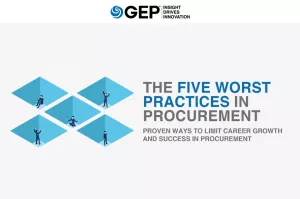Why do some procurement professionals find success on the fast track and others not so much?
Because successful procurement professionals have a solid grasp on the perspectives and priorities of the people they serve.
In this candid white paper, The Five Worst Practices in Procurement: Proven Ways to Limit Career Growth and Success in Procurement, industry veteran Bill Huber speaks about the five common mistakes that impede the success of procurement professionals within their own organizations.
What’s Inside:
- The wrong and right way to approach a procurement mandate
- Why just saving money through sourcing and compliance isn’t enough
- How to implement procurement automation without hiccups
This is a must-read for success-minded sourcing and procurement professionals.
Procurement organizations can be among the most challenging environments in which to make a positive impact on the future of the company, and one that does not always command the trust and respect of colleagues within that company.
Often, procurement executives try to overcompensate for perfectly reasonable limitations, instead of accepting what they realistically can and cannot accomplish with the resources at their disposal, and optimizing their true value-add within those limitations.
Procurement professionals need to step out of the box and see themselves as others see them. When they don’t, their behavior can be positively frustrating to their peers. Here, we list down five common career-limiting practices for procurement professionals. Perhaps, you may recognize a few.

1. HOW TO TOTALLY BOTCH A MANDATE FOR PROCUREMENT
It’s a fact that any spend, not under management, represents both potential cost leakage and increased risk to the company. The prevailing philosophy in procurement is that a CEO’s commitment to a policy of 100 percent purchasing compliance will drive compelling benefits to the organization, and CPOs will often work hard to obtain this commitment. The reality, however, is that it often becomes a situation of overreach. Successful management of all spend requires a significant investment in staff, technology and change management.

Procurement organizations are often called to lead by example in reducing their own costs of operation and, in nearly all cases, will be challenged to gain the necessary budget to implement a robust enough model to manage all spend on a timely, collaborative and high-quality basis. The result is that staff becomes stretched and overworked, responsiveness goes down, goodwill is lost, and the noise rises to the C-Suite.
A better way is to approach a mandate as a journey, on which you map a strategy to build on a succession of increasing wins that you can support robustly with the resources at your disposal.
“The prevailing philosophy in procurement is that a CEO’s commitment to a policy of 100 percent purchasing compliance will drive compelling benefits to the organization, and CPOs will often work hard to obtain this commitment. The reality, however, is that it often becomes a situation of overreach.”
2. HOW TO GET IGNORED BY THE C-SUITE
In procurement, we have our own lexicon of terms that are important to us, but do not translate into the language or the agenda of the C-Suite. We presume that our goals are among the most important goals to others. We act as though saving money through sourcing and compliance is the only way to ensure business advantage and proclaim that if the sourcing process is not followed, all will fall apart.

We need to become more sophisticated in translating negotiated savings to realized savings and EBIDTA, and how we define value in strategic deals (it’s not always savings or even TCO, but rather the value proposition of the capabilities being acquired). We need to put in place better prioritization models so that we invest our time and best resources on the initiatives that are most critical to the company.
Procurement professionals are often perceived to be strident by rest of their colleagues, and we need to learn to put procurement’s success criteria in the correct context of the overall agenda of the business leaders — with P&L responsibility. We are part of the company’s ecosystem, not the center of it.
“We presume that procurement’s goals are among the most important goals to others. We act as though saving money through sourcing and compliance is the only way to ensure business advantage.”
3. HOW TO OVERPROMISE AND UNDERDELIVER WHILE INCREASING BUREAUCRACY
We commit to service-level objectives, but often don’t measure them. If we can’t meet a timeline, we make excuses explaining how busy we are or how we didn’t get something that we need. The fact is, we don’t actually do the analysis, realistically assess our existing workload, and lay out expectations of what is required before we commit to a time frame. So, a promise of Tuesday becomes Thursday and drags on to Monday, and we wonder why others don’t always find us to be credible.

“We commit to service-level objectives, but often don’t measure them. We don’t actually do the analysis, realistically assess our existing workload, and lay out expectations of what is required before we commit to a time frame.”
4. HOW TO REDUCE AGILITY OF THE COMPANY AND HAMPER BUSINESS
Often, we inject ourselves into a deal in process, and commit to delivering savings (by browbeating the supplier into lowering prices) without adequate research on the context of the deal or the actual market for a unique product or service. Furthermore, where we lack capacity, we often put such deals into the queue and are unable to give them the timely attention that they deserve
There are many cases where the value of a deal to the company is diminished by delays in execution. Yet, most procurement organizations have no consistent mechanism for addressing the total business case in the context of analyzing the financial benefit that will be eroded by not executing promptly, compared with the potential benefit of additional intervention by procurement. We typically don’t have a clue about what the total business case is (macro view) and only have a view of the price or total cost of ownership (micro view). This is procurement myopia, and needs to be overcome if we are to consistently add real value.

“We commit to delivering savings... without adequate research on the context of the deal or the actual market for a unique product or service.”
5. HOW TO MESS UP PROCUREMENT AUTOMATION
It’s a fact. There are some remarkable procurement tools and technologies on the market right now. Without a doubt, they can help enterprise procurement teams boost efficiency, transparency and productivity. But when we finally secure the funds to purchase and implement them, we frequently fail to recognize, plan or budget for organizational change management and other non-IT support costs.
Roll-outs falter and stall because we underestimate the amount of effort that it takes to properly think through and address the different ways that individuals buy and use different commodities in different geographies. We fail to provide for adequate training, communications, help desks and on-going support. So we fumble on the very verge of what should be a moment of triumph. The result is another investment that failed to meet the business case.
“Roll-outs falter because we underestimate the amount of effort it takes to address the variety of ways individuals buy.”
HOW CAN WE AVOID THESE MISTAKES?
If our objective is to be a true “strategic” procurement organization, then we need to think beyond our own agendas and perceptions and look at ourselves through the eyes of those whom we need to support and enable. This means adopting a more intelligent, thoughtful and agile way of procurement. Once we achieve this balance, we can remove many barriers and elevate our profession.
*This paper was written by Bill Huber when he was the managing director at Alsbridge.
Bill Huber, currently partner at ISG, held high-profile positions in procurement leadership at several major U.S. companies prior to his ongoing success on the consulting and advisory side of the business. Bill is a recognized thought leader and sought-after speaker at major industry events.

